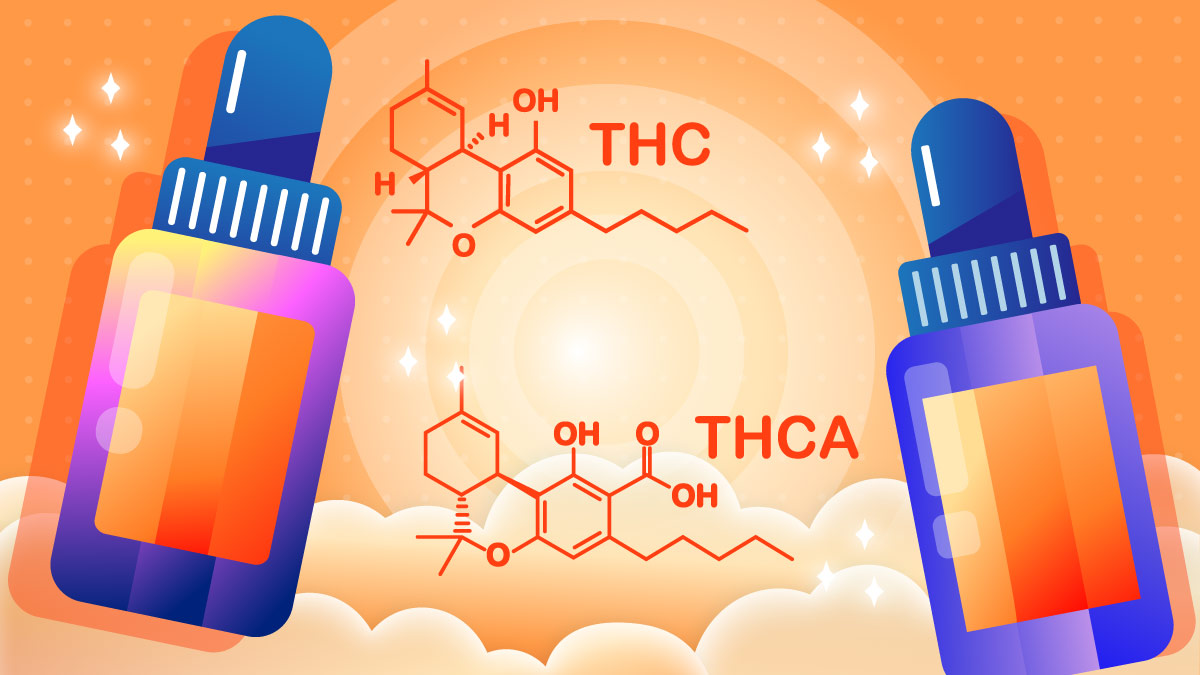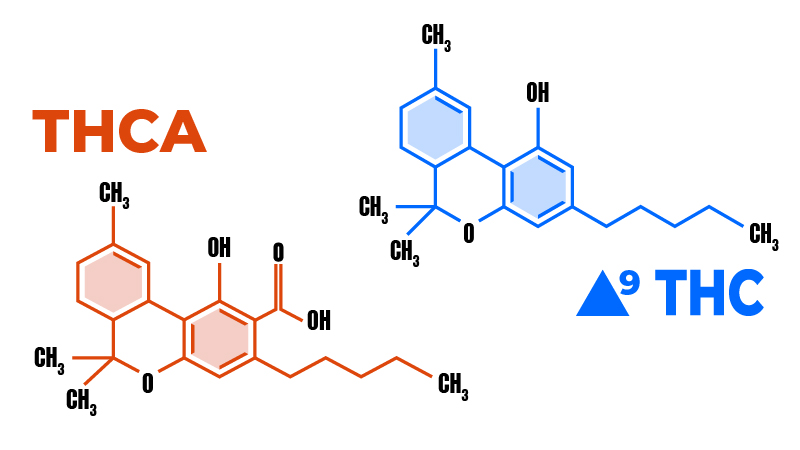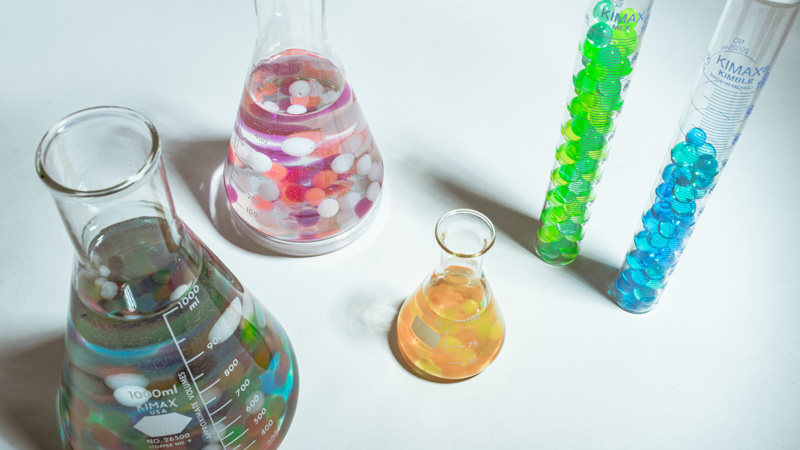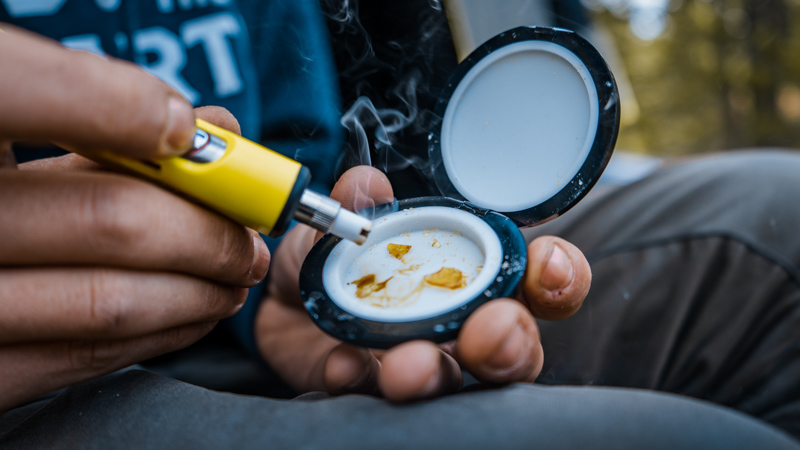THC vs. THCA: What Are the Differences?

In this article, we break down the differences between THCA and THC. THCA is the acidic precursor of THC; it won’t get you high, but it offers several health benefits that exceed the potential of THC. Here you’ll learn everything about THCA and THC, from their potency to the effects on the endocannabinoid system, safety, and available products.
Tetrahydrocannabinolic acid (THCA) is the inactive precursor of THC that occurs in raw or live cannabis plants. It converts to THC when you expose the plant to heat and light — the process is known as decarboxylation.
The major difference between THCA and THC is that THCA won’t get you high. THC, on the other hand, can induce a psychoactive experience marked by euphoria, appetite stimulation, pain relief, altered perception of time, and sharpened senses.
But that’s not the end. Preliminary research suggests that THCA can be therapeutically more beneficial than THC in some areas.
Both compounds can act synergistically with each other, especially when accompanied by minor cannabinoids and terpenes.
Here’s everything you need to know about the differences between THCA and THC.
THCA vs. THC (Summary)
THCA is non-intoxicating. It won’t get you high because it doesn’t activate CB1 receptors in the brain and central nervous system. Both THCA and THC are used to treat epilepsy, vomiting, nausea, pain, and inflammation.
Here are the core differences between THCA and THC:
- THC is the acidic form of THC. As a precursor, it’s not active and doesn’t induce intoxication.
- THC results from the decarboxylation of THCA when exposed to light and heat. It can make you high and impair your cognitive performance.
- THCA molecules are larger than THC molecules. This means that THC has a weak affinity with CB1 and CB2 receptors.
- THC’s strong affinity with CB1 receptors is the reason why you get high from consuming cannabis.
What is THCA?
THCA (Tetrahydrocannabinolic acid) is a non-psychotropic cannabinoid found in living cannabis plants. It’s an acid that can transform into THC when you heat it or expose it to light.
THCA doesn’t bind well with either of the cannabinoid receptors in the endocannabinoid system (ECS). However, it can inhibit COX-1 and COX-2 enzymes, reducing pain and lowering inflammation (1). Both these enzymes release prostaglandin, which promotes pain, inflammation, and fever.
What is THC?
Decarboxylating (heating) cannabis causes THCA to lose the additional carboxyl group, enabling conversion to THC (2).
Unlike THCA, THC is the agonist of both types of cannabinoid receptors (CB1 and CB2).
When THC binds to the CB1 receptors, it produces a range of psychoactive effects, including euphoria, hunger, altered perception of time, increased senses, pain relief, and deep relaxation (3).
These effects can be more energizing or sedating depending on the terpene content of a specific strain and the ratios between THC and other cannabinoids.
THC vs. THCA: What’s the Difference?

Although THC and THCA are closely related and share some health benefits, they use different mechanisms to produce their effects.
Here’s what you need to know about the main differences between THCA and THC.
Psychoactivity
As mentioned earlier, THC can get you high because it activates the CB1 receptors in your brain and nervous system.
THCA, on the other hand, is non-intoxicating due to its weak affinity with CB1 receptors.
Keep in mind that THC has a biphasic nature. In other words, low and moderate doses are relaxing, while high doses may elevate anxiety and cause paranoia on top of confusion, dizziness, and increased heartbeat.
This isn’t an issue with THCA. No matter how much you take, you won’t get buzzed until you smoke or vape a THCA product.
Health Benefits
THCA and THC have promising medicinal potential, but they have slightly different applications besides pain relief, nausea reduction, and neuroprotection.
Health Benefits of THCA
- Anti-inflammatory effects (useful for treating arthritis, fibromyalgia, and lupus)
- Neuroprotective properties (good for dementia)
- Antiemetic properties (may help with appetite loss, nausea, and vomiting)
- Anti-proliferative effects (may slow the growth and spread of cancer)
- Antispasmodic
- Sleep aid
- Pain reliever
- Appetite booster
- Potent antioxidant
Health Benefits of THC
Aside from all the potential benefits of THCA from the above list, potential benefits of THC include:
- Harm-reduction tools, thanks to the ability to reduce the motivation of using rewarding substances like opioids, alcohol, and heroin.
- Blood sugar reduction
- Lower fasting insulin levels and a smaller waistline
- May reduce eye pressure responsible for glaucoma
- Elevated levels of anandamide, the natural endocannabinoid that regulates anxiety, pleasure, fear, pain, and other functions of the body.
Safety
THCA is considered safer than THC, but both can cause side effects when you go overboard.
Side Effects of THC
- Dry mouth
- Dry, red eyes
- Dizziness
- Sedation
- Confusion
- Problems with coordination
- Short-term memory impairment
- Anxiety
- Paranoia
- Cold sweats
- Increased heartbeat
- An acute drop in blood sugar levels (greening out)
Side Effects of THCA
- Stomach upset
- Headache
- Dry mouth
- Diarrhea
Studies on THC vs. THCA

While THC has been studied for many years in human clinical trials, the research on THCA has a lot to catch up with.
In a 2012 preclinical study published in Phytomedicine, the authors found that THCA can help protect the brain against damage and slow the onset of neurodegenerative diseases (4).
A 2013 study on animal models and cell cultures suggested that THCA may prevent the spread of prostate cancer cells (5).
A 2017 study conducted by the Institute of Plant Sciences, Department of Gastroenterology and Hepatology, and the Sackler Faculty of Medicine, Israel, found that THCA may offer stronger anti-inflammatory effects than CBD and THC (6).
While THCA alone may not treat epilepsy, a recent study on 272 medical cannabis patients suggests a combination of THCA, CBD, and THC is promising as a novel form of treatment.
Over 80% of patients reported reduced seizure frequency and intensity as a result of cannabis consumption. 10% experienced no seizures at all. The authors concluded that they observed only a few mild side effects, suggesting CBD, THC, and THCA cannabis formulations are safe and effective (7).
How to Decarboxylate THCA
Even though the most common decarboxylation process involves throwing dried cannabis buds into the oven and heating them for around 60 minutes, there are many ways that THCA can convert to THC.
- Sunlight exposure: THCA turns into THC at various paces throughout its life cycle, depending on the amount of time the plant sits in the warm sun.
- Room-temperature conversion: THCA also converts to THC when sitting at room temperature for some time. When you submerge cannabis in olive oil, 22% of the THCA content will turn into THC. Under the same conditions, 67% will be activated when the plant is submerged in ethanol. Storing the plant at room temperature with a little light exposure will turn 20% of its THCA into THC.
- Smoking: Extremely high temperatures convert most of THCA to THC. However, not all THCA will be converted; some amount will turn into waste because the combustion is too extreme for cannabinoids to handle.
- Vaporization: It’s a more subtle way of heating THCA than smoking. Vaporization gives you more accurate control over temperatures, maximizing the extraction of THC while saving some minor cannabinoids and terpenes.
- Dabbing: Dabbing is a flash-vaporization method that can convert THCA into THC. It burns off other cannabinoids and terpenes, so the high is stronger and more psychedelic.
- Baking: If you want to make THC edibles, baking is the best way to decarboxylate THCA. All you need to do is preheat the oven to 110 degrees Celsius and keep your dry buds in there for 45-60 minutes, depending on the flower’s moisture level.
Related: What Exactly Is CBD Decarboxylation?
THCA vs. THC: Calculating Cannabis Potency
There is no THC without THCA, so the cannabinoid is paramount for calculating the potency of a cannabis strain, even though it’s the THC that gets you high.
The most effective method for measuring the potency of cannabis is gas chromatography. This method applies enough heat to the plant material in the test to decarboxylate THCA and turn it into THC.
Since potency is often expressed in THC percentage, gas chromatography will help you directly determine the potency of your product.
However, decarboxylation causes the cannabis buds to lose a significant amount of weight because THCA molecules get their carbonyl groups removed. If you want to determine the potency of a raw cannabis strain accurately, you need to consider that difference.
Here’s the formula:
THC total = (% THCA) x [final mass/initial mass] + (% THC)
This way, you can estimate the total THC present in the raw cannabis plant. This is also called the maximum THC, as in real life, under typical combustion, not all THCA turns into THC. Studies show that between 30-70% of THCA in a strain may not turn into THC.
THCA isn’t the Only Cannabinoid Acid
Most cannabinoids, such as CBD, CBG, and THCV, are found in the acidic form (CBDA, CBGA, and THCVA) when cannabis is harvested. New cannabinoid acids are still being discovered. Like THCA, these acids need to be decarboxylated before interacting with cannabinoid receptors.
THCA vs. Other Cannabinoids
Wondering how THCA compares to other non-psychoactive cannabinoids in hemp? Here’s a quick rundown of similarities and differences.
THCA vs. CBD
- THCA and CBD are both non-intoxicating. They won’t get you high when consumed.
- They have a little binding affinity with CB1 and CB2 receptors, but CBD is a negative allosteric modulator of CB1 receptors when THC tries to interact with them. This modulatory effect counteracts the psychotropic effects of THC.
- THC is an acidic precursor, while CBD is a non-acidic pharmacologically active form of cannabidiolic acid (CBDA).
THCA vs. CBDA
- While CBDA and THCA are both cannabinoid acids, CBDA won’t turn into THC when you decarboxylate it. CBDA transforms into CBD, which is also non-intoxicating.
- CBDA and THCA share similar anti-inflammatory properties as they both inhibit COX-2 enzymes, easing pain after an infection or injury.
- CBDA offers similar anti-nausea effects to THCA, although they use different mechanisms. CBDA does this through serotonin receptors (5-HT1A).
THCA vs. THCV
- THCA and THCV are both members of the tetrahydrocannabinols family, though THCV is pharmacologically active. It’s a byproduct of cannabigerovarin acid (CBGVA) decarboxylation.
- THCA won’t get you high, while THCV is believed to have intoxicating effects in high doses. That’s because THCV has a gentle affinity with CB1 receptors.
- THCA can stimulate appetite; THCV, on the other hand, is an appetite suppressant.
THCA Products

THCA should be consumed at low temperatures because adding heat will transform it into THC.
Smoking THCA and vaping it at a high temperature is counterproductive, which limits your options compared to THC and CBD products.
You can find THCA in:
- THCA Flower – THCA flower is made from cannabis plants containing higher levels of THCA accompanied by CBD, CBG, and terpenes. Living cannabis flowers have a higher ratio of THCA to THC; drying, curing, and heating the buds changes these proportions.
- THCA Tinctures – raw cannabis tinctures pack a lot of THCA. They’re made from the flowers and leaves of mature cannabis plants. Once the plant spends enough time in alcohol and gives away all its therapeutic compounds, you can filter it and bottle it up.
- Raw Cannabis Juice – juicing is the most common way to extract THCA from cannabis. Raw cannabis juice is rich in THCA and boasts high levels of antioxidants, anti-inflammatory compounds, vitamins, trace minerals, and substances that help detox heavy metals from the body.
- THCA Diamonds – also known as THCA crystalline – are a potent form of cannabis extracts, reaching 90-99% THCA. Manufacturers combine high-quality hemp extract with acetic acid and hexane to make diamonds. When all the plant compounds are stripped from the extract, lab workers run it through a reactionary vessel using a special solvent. THCA diamonds bind, crystalize, and constitute a solid substance during this process. You can place them under the tongue or dab them if you want to get high from decarboxylation.
- Transdermal Patches – THCA patches are less common, but they can effectively address problems like inflammation, pain, and nausea. When you place a THCA transdermal patch on the trouble spot, the compounds quickly absorb into your skin and enter the bloodstream.
Where to Buy THCA
THCA products are becoming increasingly popular; you shouldn’t have problems finding them in a nearby hemp store.
But, not all THCA products are made equal, and due to the lack of regulations in the hemp industry, there’s no shortage of inferior, untested products that can be dangerous to your health.
That’s why most transactions on cannabis products are made online. Online stores provide more options for verifying your potential vendor. Most importantly, you can look into third-party lab reports to check if your product is free from pesticides, heavy metals, solvents, and mold. The certificate of analysis (CoA) from a third-party lab should also tell you how much THCA is in the tested batch.
Lower prices are another reason to buy THCA products online. The presence of the middleman is reduced to a bare minimum. You can take advantage of coupon codes, reward programs, subscription orders, and bulk pricing to get great deals on high-quality THCA extracts from reputable brands.
But perhaps the best part about shopping for THCA online is convenience. You can browse through hundreds of different products; compare prices, formulas, potencies, and flavors — without leaving your house. No need to bounce between several stores before you get what you’re looking for. It’s a serious time-saver.
THCA vs. THC: Key Takeaways
Although research on THCA is in its infancy, THCA products are a great way to reap the benefits of cannabis without getting high.
Preclinical research suggests THCA is a promising treatment for inflammation, pain, nausea, vomiting, and neurodegeneration.
THCA occurs in high concentrations in living cannabis plants, so if you want to get the most out of your THCA content, the plant material should be processed right after the harvest.
The most common forms of THCA are juices, tinctures, and diamonds. When you buy THCA online, make sure to choose reputable sources that provide batch-specific CoAs for their products.
Just remember, smoking or vaping THCA will convert it into THC, causing a potent high, especially when you use THCA concentrates.
Sources:
- Ruhaak, L. R., Felth, J., Karlsson, P. C., Rafter, J. J., Verpoorte, R., & Bohlin, L. (2011). Evaluation of the cyclooxygenase inhibiting effects of six major cannabinoids isolated from Cannabis sativa. Biological & pharmaceutical bulletin, 34(5), 774–778. https://doi.org/10.1248/bpb.34.774
- Wang, M., Wang, Y. H., Avula, B., Radwan, M. M., Wanas, A. S., van Antwerp, J., Parcher, J. F., ElSohly, M. A., & Khan, I. A. (2016). Decarboxylation Study of Acidic Cannabinoids: A Novel Approach Using Ultra-High-Performance Supercritical Fluid Chromatography/Photodiode Array-Mass Spectrometry. Cannabis and cannabinoid research, 1(1), 262–271. https://doi.org/10.1089/can.2016.0020
- Vučković, S., Srebro, D., Vujović, K. S., Vučetić, Č., & Prostran, M. (2018). Cannabinoids and Pain: New Insights From Old Molecules. Frontiers in pharmacology, 9, 1259. [1]
- Moldzio, R., Pacher, T., Krewenka, C., Kranner, B., Novak, J., Duvigneau, J. C., & Rausch, W. D. (2012). Effects of cannabinoids Δ(9)-tetrahydrocannabinol, Δ(9)-tetrahydrocannabinolic acid, and cannabidiol in MPP+ affected murine mesencephalic cultures. Phytomedicine: international journal of phytotherapy and phytopharmacology, 19(8-9), 819–824. [2]
- De Petrocellis, L., Ligresti, A., Schiano Moriello, A., Iappelli, M., Verde, R., Stott, C. G., Cristino, L., Orlando, P., & Di Marzo, V. (2013). Non-THC cannabinoids inhibit prostate carcinoma growth in vitro and in vivo: pro-apoptotic effects and underlying mechanisms. British journal of pharmacology, 168(1), 79–102. [3]
- Nallathambi, R., Mazuz, M., Ion, A., Selvaraj, G., Weininger, S., Fridlender, M., Nasser, A., Sagee, O., Kumari, P., Nemichenizer, D., Mendelovitz, M., Firstein, N., Hanin, O., Konikoff, F., Kapulnik, Y., Naftali, T., & Koltai, H. (2017). Anti-Inflammatory Activity in Colon Models Is Derived from Δ9-Tetrahydrocannabinolic Acid That Interacts with Additional Compounds in CannabisExtracts. Cannabis and cannabinoid research, 2(1), 167–182. [4]
- Sulak, D., Saneto, R., & Goldstein, B. (2017). The current status of artisanal cannabis for the treatment of epilepsy in the United States. Epilepsy & behavior: E&B, 70(Pt B), 328–333. [5]